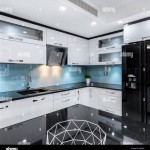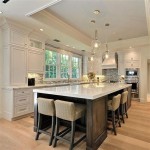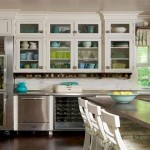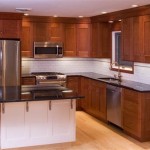Round Rugs Under Kitchen Tables: Functionality, Style, and Considerations
The selection of a rug for placement under a kitchen table represents a crucial design decision impacting both the aesthetic appeal and functional performance of the kitchen space. While various shapes and sizes exist, round rugs offer a distinctive visual element and particular benefits within the context of a kitchen dining area. This article delves into the rationale for choosing a round rug beneath a kitchen table, exploring design considerations, practical advantages, and potential drawbacks.
Enhancing Visual Appeal and Softening Hard Lines
Kitchens, often characterized by rigid lines and hard surfaces from cabinetry, countertops, and appliances, can benefit significantly from the introduction of a round rug. The circular shape provides a visual contrast that softens the overall appearance of the room. The absence of sharp corners in a round rug creates a more relaxed and inviting atmosphere, contributing to a sense of warmth and comfort within the kitchen dining space. This contrasts with the potentially sterile feel that can arise from purely angular design elements.
A round rug can serve as a focal point, drawing the eye and establishing a central anchor within the kitchen. This is particularly effective when paired with a round or oval kitchen table, creating a cohesive and harmonious visual flow. The rug effectively defines the dining area, separating it from the rest of the kitchen and designating it as a distinct space for meals and gatherings. This visual separation can be especially useful in open-concept kitchens where the dining area seamlessly blends with the cooking and preparation zones.
Beyond the shape itself, the texture and color of the round rug contribute significantly to its aesthetic impact. A plush, shag rug can add a layer of tactile luxury, transforming a utilitarian kitchen into a more comfortable and inviting space. Conversely, a low-pile rug with a bold geometric pattern can introduce a contemporary and dynamic element to the kitchen's design. The selection of appropriate colors is critical; a rug with hues that complement the existing cabinetry, countertops, and flooring can tie the entire room together. Conversely, a strategically chosen rug with contrasting colors can inject personality and visual interest, preventing the kitchen from feeling monotonous.
Consider the existing architectural style of the kitchen when selecting a round rug. In a traditional kitchen, a rug with a classic Persian or Oriental design can enhance the room's timeless elegance. In a modern kitchen, a rug with a minimalist pattern or abstract design can complement the clean lines and contemporary aesthetic. The rug serves as a tool to reinforce and amplify the overall design theme, ensuring that the kitchen feels cohesive and well-integrated.
Furthermore, the size of the round rug plays a crucial role in its aesthetic effectiveness. A rug that is too small will appear insignificant and fail to adequately define the dining area. Conversely, a rug that is too large may overwhelm the space and encroach upon the surrounding areas. The ideal size allows for adequate coverage under the table and chairs, ensuring that chairs remain on the rug even when pulled out for seating. This balance is essential for both visual appeal and functional performance.
Practical Benefits: Protection, Comfort, and Noise Reduction
Beyond its aesthetic contributions, a round rug beneath a kitchen table offers several practical advantages. One primary benefit is the protection it provides for the underlying flooring. Kitchens are high-traffic areas prone to spills, dropped food, and scratches from moving chairs. A rug acts as a barrier, absorbing impacts and preventing damage to the floor. This is particularly important for delicate flooring materials such as hardwood, tile, or laminate, which are susceptible to scratching and staining.
The presence of a rug can also significantly enhance the comfort of the kitchen dining area. A rug provides a softer surface underfoot, making it more pleasant to stand and walk around the table. This is particularly beneficial for individuals who spend extended periods in the kitchen, such as those preparing meals or entertaining guests. The added cushioning can reduce fatigue and improve overall comfort, making the kitchen a more enjoyable space to be in.
Noise reduction is another notable benefit of placing a rug under a kitchen table. Kitchens tend to be noisy environments due to the clatter of dishes, the hum of appliances, and the echoes of hard surfaces. A rug absorbs sound waves, diminishing the amount of noise that reverberates throughout the room. This is especially valuable in open-concept kitchens, where noise can easily travel to adjacent living areas. By reducing the ambient noise level, a rug contributes to a more peaceful and relaxing dining experience.
Selecting a rug with appropriate material and construction is essential for maximizing its practical benefits. Rugs made from durable, stain-resistant materials such as synthetic fibers (e.g., nylon, polypropylene) are ideal for kitchens, as they can withstand heavy use and resist spills. Low-pile rugs are generally preferable to high-pile rugs, as they are easier to clean and less likely to trap food particles. A rug with a non-slip backing is crucial for preventing accidents, ensuring that the rug stays securely in place and does not slide around on the floor.
Regular maintenance is critical for preserving the cleanliness and appearance of the rug. Frequent vacuuming is necessary to remove dirt, dust, and food debris. Promptly addressing spills and stains is essential for preventing them from setting in. Depending on the material, professional cleaning may be required periodically to maintain the rug's freshness and prevent the build-up of odors. By adopting a proactive approach to maintenance, the rug can continue to provide protection, comfort, and noise reduction for years to come.
Potential Drawbacks and Considerations
While round rugs offer several advantages for use under kitchen tables, potential drawbacks must be considered. Chief among these is the challenge of achieving a perfect fit. Unlike rectangular rugs, which can easily align with the straight edges of a room, round rugs require careful measurement and placement to ensure they are centered under the table and do not obstruct pathways or create awkward gaps.
The size of the kitchen itself must be taken into account. In smaller kitchens, a large round rug may overwhelm the space, making it feel cramped and cluttered. Conversely, in larger kitchens, a small round rug may appear insignificant and fail to adequately define the dining area. It is crucial to select a rug size that is proportional to the dimensions of the kitchen and the table it will be placed under.
Another consideration is the layout of the kitchen. In kitchens with irregular shapes or architectural features, a round rug may not be the most practical choice. Rectangular or custom-shaped rugs may be better suited for these types of spaces, as they can be tailored to fit the specific dimensions and contours of the room. Evaluating the kitchen's layout is essential for determining whether a round rug will effectively integrate into the overall design.
The style of the kitchen table also influences the suitability of a round rug. While round rugs generally complement round or oval tables, they may not be the best choice for rectangular or square tables. The contrasting shapes can create a visual imbalance, detracting from the overall aesthetic harmony of the room. Consider the shape of the table and its relationship to the rug's shape when making a selection.
Cleaning and maintenance can present challenges, particularly in high-traffic kitchens. Round rugs may be more difficult to maneuver and clean than rectangular rugs, especially if they are large and heavy. The circular shape can also make it more difficult to vacuum and spot-clean effectively, particularly around the edges. Choosing a rug material that is easy to clean and maintain is essential for mitigating these challenges.
Finally, cost is a factor to consider. Round rugs, particularly those made from high-quality materials or featuring intricate designs, can be more expensive than rectangular rugs of comparable size. Assessing the budget and prioritizing the desired features and benefits is crucial for making an informed decision. Exploring various options and comparing prices can help ensure that the selected rug provides the best value for the investment.
Ultimately, the decision of whether to use a round rug under a kitchen table requires careful consideration of the room's size, layout, table shape, and personal preferences. While they offer several aesthetic and practical advantages, potential drawbacks must be acknowledged and addressed. By carefully evaluating these factors, it is possible to select a round rug that enhances the beauty and functionality of the kitchen dining area.

Rules Of Thumb For Rugs Under Round Dining Tables Inspiration

22 Round Rug Decorating Ideas For Any Space Rugs Direct

Rules Of Thumb For Rugs Under Round Dining Tables Inspiration

Think Outside The Box With Round Rugs Floorspace

6 Rules For Choosing A Dining Room Rug Pretty Sources Stonegable

20 Best Dining Room Rugs 2024 Hgtv S Top Picks

Rules Of Thumb For Rugs Under Round Dining Tables Inspiration

Simple Rules For Dining Room Rugs Floorspace

Round Rugs Stylish And Durable Options Pottery Barn

Home Furniture Decor Outdoor








